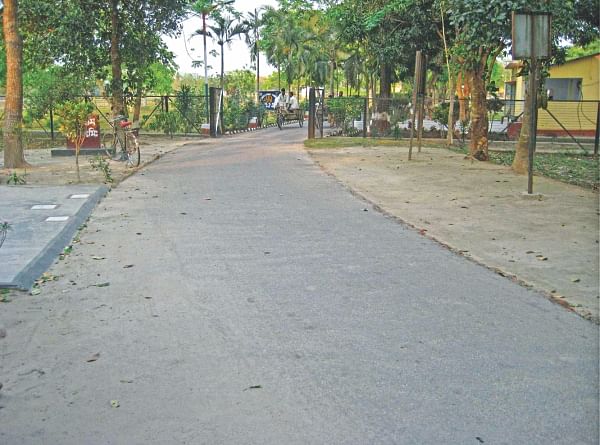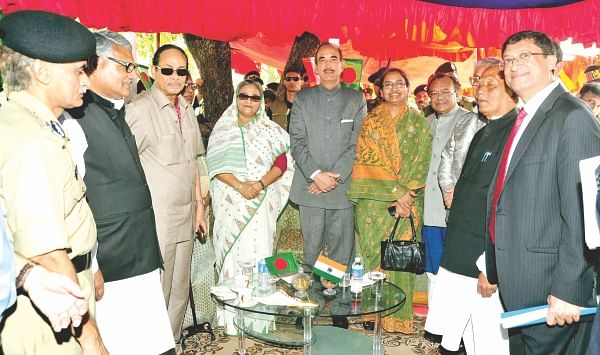| Home - Back Issues - The Team - Contact Us |
 |
| Volume 10 |Issue 41 | October 28, 2011 | |
|
|
Current Affairs
A Life of Confinement SHAKHAWAT LITON Mohammad Haran Ali has had to live a life of confinement for almost 65 years of his life. He had not committed any crime that could warrant such a life sentence. Born at Dahagram village in 1946, a few months before India's independence and partition, he became a citizen of independent East Pakistan. But he could not enjoy the freedoms of other citizens because of the 1947 partition line drawn by British rulers. The partition line made his birthplace a disconnected enclave from the mainland of his country by putting a strip of land on West Bengal-Bangladesh border under Indian territory, which blocked the way of his free movement. The emergence of Bangladesh as an independent country in 1971 changed his identity once again as a citizen, yet could not free him from his circumscribed existence. As people of his village did not have access to the mainland of Bangladesh, he says, they used to go to Mekhliganj, the surrounding Thana of Cooch Bihar in India, to sell crops and buy daily essentials. On their way they experienced numerous difficulties including a risk to their lives when they had to go through BSF camps to enter Mekhliganj. “BSF men behaved rudely with us; but we didn't have any other options but to go to Mekhliganj,” remembers Haran, a farmer of Dahagram. He says he, along with some people of his village were jailed for a month in India 30 years ago for illegally entry. Haran remembers another traumatic experience. One night, months before the India-Pakistan war in 1965, he says members of surrounding Indian areas burned the village to the ground. “We started fleeing the village to save our lives. We had tried to enter Patgram, mainland through Tin Bigha corridor. But BSF members did not allow us to pass the area. They even fired a few gunshots to prevent us from crossing the Indian territory,” remembers Haran Ali. He says many villagers however, were desperate and they crossed Indian territory in the darkness of the night and reached mainland Bangladesh. But they could not leave Dahagram permanently because they were born and brought up here and had property in the village. Like others Haran silently accepted it as fate. Yunus Ali, 50, of Dahagram village, describes people's struggle for survival. He says many people used to cross Indian territory and enter the Bangladesh mainland at night with goods and crops to sell them in local markets and back home with daily essentials. “But it was very risky as BSF men sometimes fire targeting them,” he remembers. “Yet we had to continue to do so to survive. We risked our lives to stay alive.” A Ray of Hope “The prime minister will come so I came here to listen what she says further,” Haran said. “We are very happy now. She gave us the freedom we had been awaiting for decades.” At Dahagram high school ground, Haran and Yunus were speaking to this correspondent before the prime minister arrived there. Their smiling faces told the story of how much this freedom meant to them.
At around 11:00am in the morning, an air force helicopter carrying Prime Minister Sheikh Hasina appeared in the sky of Dahagram. People waiting at the school ground burst into joyful shouts. The PM flew to the enclaves to partake in the inhabitants' joy over the freedom they would now enjoy. People inhabiting the two enclaves–Angorpota-Dahagram of Lalmonirhat district- gathered to celebrate the freedom they got. They came out of their home to thank the PM for her contribution to making the significant changes in the 18.68 square km area of two enclaves where 16,000 people have their homes. They had been denied the right to free movement for almost 64 years because of the Indian authorities' restriction on the use of Tin Bigha corridor. Bangabandhu Sheikh Mujibur Rahman had signed an agreement with India in 1974 providing for freedom of movement for the people living in the two enclaves. But his move did not secure a positive response from India at the time. But history took a new turn, on September 8 this year, when the Indian authorities let the iron gates stay open round the clock following a deal between Hasina and Indian Prime Minister Manmohan Singh. "It was a freedom of the people of the enclaves from captivity," Hasina said while addressing a public meeting at Dahagram high school ground. Momtaz Ali, 65, of Bongerbari, Dahagram enclave said: “I had dreamt for a long time of being free from this restricted life. And I wanted to die as a free human being.” He says people of the mainland did not want to get married to our sons and daughters as we were confined to the enclaves. “Now we can easily build relationships with people living on the mainland.” His son Hashmat Ali, 38, said he could not continue with his education owing to the restriction. He looks to the future. “I will educate my children as we are now free.” Diplomacy at snail's pace Complications for those living within the enclaves began with partition and became acute in 1952, with the implementation of a passport/visa system between the two countries. An official agreement in 1958 to exchange all of the enclaves in the Nehru-Noon accords had apparently been made, despite the deteriorating relations between Pakistan and India. A series of court cases in India prevented this from being implemented. The problem persisted, for close to a quarter of a century. It was not until the liberation of Bangladesh in 1971 that optimism regarding a solution to the problem came to be generated. Indira Gandhi and Sheikh Mujibur Rahman, prime ministers of India and Bangladesh, signed an agreement aimed at putting into effect the demarcation of boundaries at selected stretches of territory on May 16, 1974. Under the terms of the treaty, India was supposed to lease in perpetuity to Bangladesh an area of 178x85 square metres near the Tin Bigha corridor to connect Dahagram to Panbari of Patgram upazila in Bangladesh. But the handing over of the land was delayed due to prolonged constitutional and legal debate in India. This situation continued till October 7, 1982, when another agreement was signed. But that too failed to resolve the problem. It would take another decade for the agreement to materialise and give the people of the enclaves some opportunity of movement. On June 26, 1992, the people of the enclaves were able move through the corridor for six hours a day till June 1996, blocking any communication with the mainland rest of the time. They were allowed to use the corridor constantly for 12 hours a day between July 1996 and September 2011. And finally the September 6 agreement signed by Hasina and Manmohan opened the iron gates for 24 hours a day for inhabitants living in Angorpota- Dahagram for their free movement to mainland. A Time for People's Diplomacy Her motorcade reached the corridor area around 12:45 pm. Two Indian ministers--Health Minister Golam Nabi Azad and Minister of State for Home Affairs Jitendra Prasad Singh--along with some other government officials received the Bangladeshi leader with a red carpet welcome at the corridor. They held a meeting for half an hour, followed by refreshments. After the meeting, the Indian health minister told journalists that he and his colleague had come there to exchange greetings with Hasina and to celebrate the historic occasion. “It's a glowing example of better relations with India,” commented Hasina about keeping the iron gates at Tin Bigha corridor open for 24 hours. The celebration of the historic moment could have been more significant had West Bengal Chief Minister Mamata Banerjee appeared in the Tin Bigha on the day. She was invited by the federal Indian government but could not make it to receive PM Hasina when the latter had crossed the corridor on October 19. It was Mamata for whom India and Bangladesh failed to ink a treaty on Teesta water-sharing. The incident frustrated and annoyed both the governments and many citizens of both countries as well as. The West Bengal chief minister should come forward to expedite opening the new window for bilateral relationship between the two countries. All the 51 Bangladeshi enclaves are in Cooch Behar district of West Bengal. And Manata’s stance will dictate the fate of 111 Indian enclaves inside four districts in Bangladesh. Both India and Bangladesh government should not waste time to resolve the long-standing enclave problems. They should be inspired by the joy expressed by the inhabitants of Anogorpota- Dahagram to free people of both countries living in other enclaves inside Bangladesh and India.
The writer is Senior Reporter of The Daily Star
Copyright
(R) thedailystar.net 2011 |

